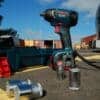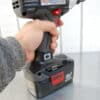Most lawnmowers come with a self-propel function that causes the mower to move on its own when it is working. The feature is made possible by the self-propelled lawnmower cable, and it increases your mowing convenience. You can turn on this function by activating the lever on top of the lawnmower’s handlebar.
Pushing your lawnmower becomes less troublesome and consumes little energy. However, the self-propelled feature can fail to work due to problems with the cable.
Table of Contents
Read this to learn how to fix a self-propelled lawnmower cable the right way.
To fix a self-propelled lawnmower cable, the best thing to do is replace the cable. Fixing the cable might seem like the best option to save cost at first. But you would eventually have to get a new one sooner than you think.
You need to replace the cable with a new one immediately by following these steps:
- Disconnect the spark plug and empty the fuel tank or tighten its lid
- Release the cable from the top handlebar
- Turn the mower over
- Detach the cable
- Fix the new cable
- Check the lawnmower drive cable and adjust it
For your mower to last long and work properly, it needs proper and regular maintenance. This includes immediate repair or replacement of any part that gets broken.
In this guide, we will explain the steps in detail, and examine some of the many benefits of using the self-propelled function on your lawnmower.
6 steps to fix a self-propelled lawnmower cable
- Disconnect the spark plug and empty/tighten the fuel tank
- Release the cable from the top handlebar
- Turn the lawnmower over
- Detach the other end of the cable
- Fix the new cable
- Check the lawnmower drive cable and adjust it
You can either remove the plug entirely or disconnect it from the engine. This is a safety measure to prevent accidental electric sparks while you work on the self-propelled cable.
After this, you need to tighten the gas tank to prevent spilling when you tilt the lawnmower. Undo the gas tank lid and place a plastic bag on top of its opening. Then return the lid and tighten it to secure the opening and prevent any lick. You can also just empty the tank.
Identify the drive cable. It is the cable that connects from the handle to the lawnmower’s body, right above the axle. Once you have located this cable, find the points where the external part of the cable is fastened on the handlebar.
It might be held together by a winged tab or a bolt. If it’s a winged tab, use pliers to push it down and drag out the cable gently.
You need to be careful here and turn it over correctly. Make sure you turn it so that the air filter faces up. Turning it the wrong way can cause problems, such as difficulty to start the engine and white smoke coming out of the engine.
This end of the cable is more difficult to remove, so you would have to be patient and persistent with it. The outer part of the cable is usually secured with a plastic winged connector. While the inner part is fastened with hooks and braided into the transmission lever arm.
As we’ve explained, you release the outer one by pushing the winged tab and dragging the cable free. But with the inner cable, you need to unhook the braided cable from this point.
You would need a needle nose plier with a long handle, a soft pad to kneel on, and bright light to see the inner parts clearly. With these, you would unhook the cable easier.
After unhooking, pull it out of the hole from the side of the upper deck.
First, check the old cable and make sure you got the proper self-propelled cable. Put the transmission end of the cable through the lawnmower’s body hole and fix the plastic winged connector to its hold.
Then use the long nose plier to connect the braided end of the cable to the transmission arm.
Then lift your mower upright and return your fuel into the tank or remove the plastic bag from the tank opening.
Lawnmower drive cables usually come with adjusters with which you can increase or decrease the length of the cable. It might be a cable connector adjuster or a cable end adjuster.
With any of these, you can adjust the cable by doing the following:
- Check if the cable is slack by a gentle push when it is in place. The cable should not bend more than a quarter of an inch.
- If it bends more than a quarter of an inch, open the lock nut and remove the outer screw to fix the slack in the inner cable.
- Do a test by turning off the engine and self-propelled lever. Then drag the lawnmower backward. The wheels should stiffen or lock. If it does not, do another readjustment.
- Another test you can do is release the self-propelled lever and pull the lawnmower backward. If it is too stiff to reverse, you have over-adjusted and might need to readjust it.
Safety precautions and important information
Before working on your mower to replace the self-propelled cable or identify the faults, ensure you wear some safety gear where applicable.
Turn off the engine and disconnect the spark plug to avoid accidental combustion. Make sure gas tanks are tightly sealed with a plastic bag to prevent spilling or leakage when you tilt the equipment. Make sure the mower is cool after turning it off before you begin.
If replacing the cable, ensure you get the correct one by taking an accurate measurement of the old one.
Other methods of fixing self-propelled lawnmower cable
- Check for loose wires — If replacing the self-propelled cable is too drastic, you can start by checking for loose wires in the connection. Find where the self-propelled cable wires are connected, and check if there are any wires hanging out of place. If you find loose wires, reattach them to the appropriate parts, and test the lawnmower.
- Ensure the self-propelled function is activated — You can also make sure that the self-propelled lever is downward. The lever is on the top handle of the lawnmower. Push it downwards to activate the function. It might be stiff, so apply force to move it downwards.
- Confirm the screws are properly fastened — One screw loose can cause your self-propelled function to fail to work. So check on all the screws and bolts connected to its cable and ensure they are all properly fixed. Fastened the screws tight.
Benefits of using the self-propelled function on your lawnmower
- Save time and effort — The self-propelled function in your lawnmower helps you cut the grass efficiently with little effort. You don’t need to exert yourself to mow the lawn. This feature allows the mower to move by itself while you guide it. Mowing your lawn then becomes stress-free and faster to do.
- Easily control the equipment — As we have explained, moving the mower becomes easy if the self-propelled feature is enabled. You can guide the mower without effort to the areas you would like to cut.
- It is noiseless and efficient — Self-propelled lawn mowers are generally noiseless, and they give your lawn a neat finish. You can customize its speed and toggle some of its settings without much effort too.
- They tend to be more durable than other mowers — You do not need to struggle with a self-propelled lawnmower. You would not need to pull or push it while using it. Because of this, it tends to last longer than other types of the lawnmower, giving you better value for your money. The self-propelled function on lawnmowers is incredibly useful, and since you do not get to roughly pull or push while using this feature, it can even make your mower last longer.
By following the steps outlined above, you enjoy the benefits of this type of mower if you are having trouble with yours. Mowing will be less stressful and take less time with a self-propelled lawnmower.





